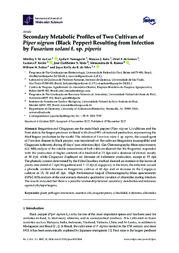Secondary metabolic profiles of two cultivars of Piper nigrum (Black Pepper) resulting from infection by Fusarium solani f. sp. piperis.
Secondary metabolic profiles of two cultivars of Piper nigrum (Black Pepper) resulting from infection by Fusarium solani f. sp. piperis.
Author(s): LUZ, S. F. M. da; YAMAGUCHI, L. F.; KATO, M. J.; LEMOS, O. F. de; XAVIER, L. P.; MAIA, J. G. S.; RAMOS, A. de R.; SETZER, W. N.; SILVA, J. K. do R. da
Summary: Bragantina and Cingapura are the main black pepper (Piper nigrum L.) cultivars and the Pará state is the largest producer in Brazil with about 90% of national production, representing the third largest production in the world. The infection of Fusarium solani f. sp. piperis, the causal agent of Fusarium disease in black pepper, was monitored on the cultivars Bragantina (susceptible) and Cingapura (tolerant), during 45 days? post infection (dpi). Gas Chromatography-Mass spectrometry (GC-MS) analysis of the volatile concentrates of both cultivars showed that the Bragantina responded with the production of higher contents of α-bisabolol at 21 dpi and a decrease of elemol, mostly at 30 dpi; while Cingapura displayed an decrease of δ-elemene production, except at 15 dpi. The phenolic content determined by the Folin Ciocalteu method showed an increase in the leaves of plants inoculated at 7 dpi (Bragantina) and 7?15 dpi (Cingapura); in the roots, the infection caused a phenolic content decrease in Bragantina cultivar at 45 dpi and an increase in the Cingapura cultivar at 15, 30 and 45 dpi. High Performance Liquid Chromatography-Mass spectrometry (HPLC-MS) analysis of the root extracts showed a qualitative variation of alkamides during infection. The results indicated that there is a possible relationship between secondary metabolites and tolerance against phytopathogens.
Publication year: 2017
Types of publication: Journal article
Unit: Embrapa Eastern Amazon
Keywords: Doença, Fusarium, Pimenta preta, Óleos essenciais
Observation
Some of Embrapa's publications are published as ePub files. To read them, use or download one of the following free software options to your computer or mobile device. Android: Google Play Books; IOS: iBooks; Windows and Linux: Calibre.
Access other publications
Access the Agricultural Research Database (BDPA) to consult Embrapa's full library collection and records.
Visit Embrapa Bookstore to purchase books and other publications sold by Embrapa.

